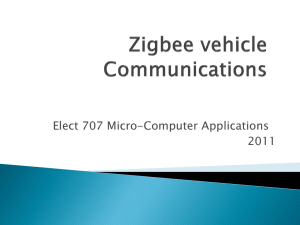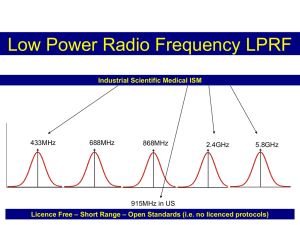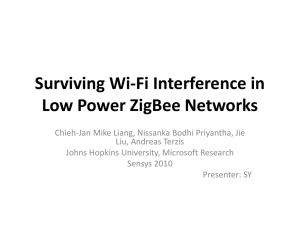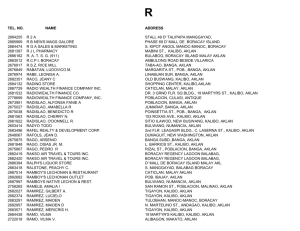C-LAN White Paper
advertisement
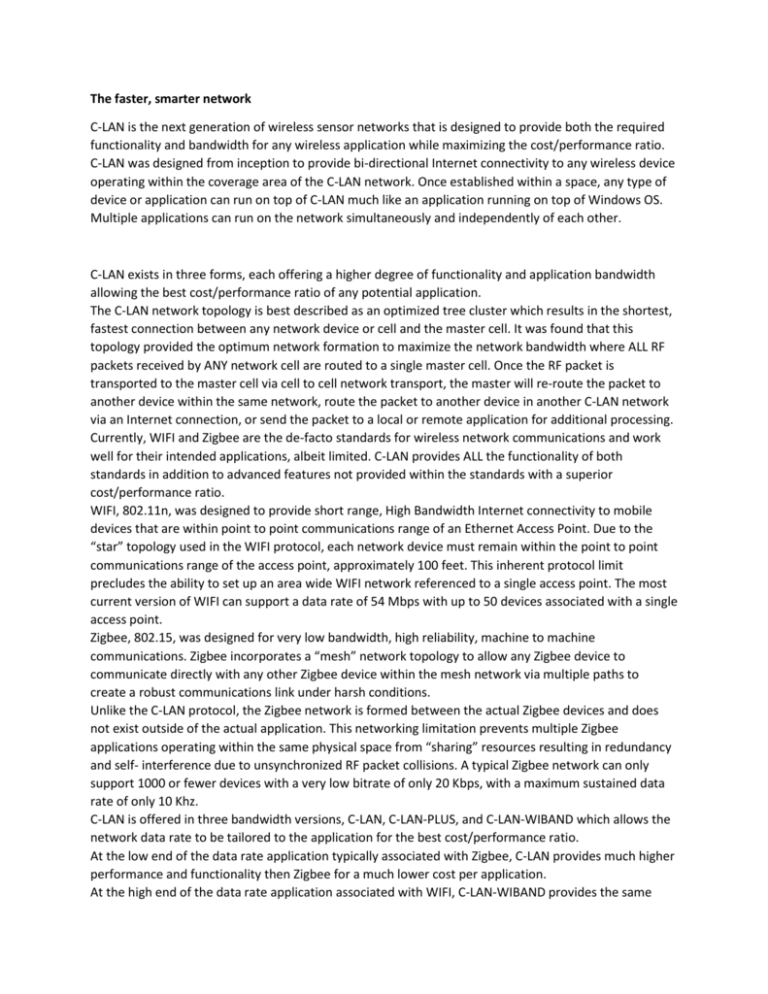
The faster, smarter network C-LAN is the next generation of wireless sensor networks that is designed to provide both the required functionality and bandwidth for any wireless application while maximizing the cost/performance ratio. C-LAN was designed from inception to provide bi-directional Internet connectivity to any wireless device operating within the coverage area of the C-LAN network. Once established within a space, any type of device or application can run on top of C-LAN much like an application running on top of Windows OS. Multiple applications can run on the network simultaneously and independently of each other. C-LAN exists in three forms, each offering a higher degree of functionality and application bandwidth allowing the best cost/performance ratio of any potential application. The C-LAN network topology is best described as an optimized tree cluster which results in the shortest, fastest connection between any network device or cell and the master cell. It was found that this topology provided the optimum network formation to maximize the network bandwidth where ALL RF packets received by ANY network cell are routed to a single master cell. Once the RF packet is transported to the master cell via cell to cell network transport, the master will re-route the packet to another device within the same network, route the packet to another device in another C-LAN network via an Internet connection, or send the packet to a local or remote application for additional processing. Currently, WIFI and Zigbee are the de-facto standards for wireless network communications and work well for their intended applications, albeit limited. C-LAN provides ALL the functionality of both standards in addition to advanced features not provided within the standards with a superior cost/performance ratio. WIFI, 802.11n, was designed to provide short range, High Bandwidth Internet connectivity to mobile devices that are within point to point communications range of an Ethernet Access Point. Due to the “star” topology used in the WIFI protocol, each network device must remain within the point to point communications range of the access point, approximately 100 feet. This inherent protocol limit precludes the ability to set up an area wide WIFI network referenced to a single access point. The most current version of WIFI can support a data rate of 54 Mbps with up to 50 devices associated with a single access point. Zigbee, 802.15, was designed for very low bandwidth, high reliability, machine to machine communications. Zigbee incorporates a “mesh” network topology to allow any Zigbee device to communicate directly with any other Zigbee device within the mesh network via multiple paths to create a robust communications link under harsh conditions. Unlike the C-LAN protocol, the Zigbee network is formed between the actual Zigbee devices and does not exist outside of the actual application. This networking limitation prevents multiple Zigbee applications operating within the same physical space from “sharing” resources resulting in redundancy and self- interference due to unsynchronized RF packet collisions. A typical Zigbee network can only support 1000 or fewer devices with a very low bitrate of only 20 Kbps, with a maximum sustained data rate of only 10 Khz. C-LAN is offered in three bandwidth versions, C-LAN, C-LAN-PLUS, and C-LAN-WIBAND which allows the network data rate to be tailored to the application for the best cost/performance ratio. At the low end of the data rate application typically associated with Zigbee, C-LAN provides much higher performance and functionality then Zigbee for a much lower cost per application. At the high end of the data rate application associated with WIFI, C-LAN-WIBAND provides the same bandwidth as WIFI but extends the network far beyond the physical range of a typical access point while at the same time increasing the number of WIFI devices that can access the network via a single access point to 1000’s. C-LAN-PLUS is an intermediate bandwidth network offering network performance between C-LAN and C-LAN-WIBAND. C-LAN C-LAN® is the lowest bandwidth version and the most similar to Zigbee in performance. C-LAN provides a bitrate of 2 Mbps, with a sustained data rate of 50 Khz. C-LAN provides all the functions of Zigbee plus additional features due to the much higher bitrate and sustained data rate. Unlike Zigbee, C-LAN can support compressed audio and low frame rate compressed JPEG files at up to 5 frames per sec. This higher performance allows more advanced sensors and systems to utilize the resident C-LAN network which cannot be supported by Zigbee. Audio and video meta-data can be transported to any cloud server by C-LAN if the bandwidth requirements are within that of the basic C-LAN as described. Class 1 C-LAN devices are supported by C-LAN. Typical applications that can be supported by the basic C-LAN are camera tracking, prop and actor tracking, motion capture, 2D to 3D conversion, to name a few. C-LAN-Plus C-LAN-PLUS® is a higher bandwidth version of the original C-LAN and incorporates the same optimized tree cluster network topology. C-LAN-PLUS provides a bitrate of 4 Mbps and a sustained data rate of 96 Khz, sufficient to support CD quality audio and moderate frame rate uncompressed JPEG files. The higher bandwidth allows advanced sensors and systems to operate on C-LAN-PLUS which require more data thru-put then can be provided by the basic C-LAN. Higher bandwidth audio and video meta-data can be transported to any cloud server by C-LAN-PLUS if the bandwidth requirements are within that of C-LAN-PLUS as described. Class 1 and 2 C-LAN devices are supported by C-LAN-PLUS. Typical applications that can be supported by C-LAN-PLUS are the same as C-LAN but can support a higher sample rate and/or support a larger number of Class 1 or 2 devices. C-LAN-WIBAND C-LAN-WIBAND® is the highest bandwidth version of C-LAN also incorporating the same optimized tree clusterl network topology. C-LAN-WIBAND provides a bit-rate of 54 Mbps with a sustained data rate of over 10 Mhz, which is identical to the current WIFI 802.11n standard. C-LAN-WIBAND can be used to transport standard WIFI data packets much like a WIFI extender but without any limit on the network coverage. Class 1, 2, and 3 C-LAN, and WIFI enabled devices, are supported by C-LAN-WIBAND. C-LAN-WIBAND can support uncompressed streaming audio and video identical to any WIFI wireless router but with an unlimited range. Audio and video meta-data can be transported to any cloud server by C-LAN-WIBAND if the bandwidth requirements exceed that of C-LAN-WIBAND as previously described. Higher bandwidth versions of C-LAN-WIBAND can easily be adapted to support the new Super-WIFI standards needed to support HD video and uncompressed multi-channel audio streaming once the new standard emerges. Summary of similarities and differences between WIFI, Zigbee, and the three forms of C-LAN Features WIFI C-LANWIBAND C-LAN-PLUS C-LAN Zigbee Bluetooth Low Energy (BLE) Protocol 802.11n proprietary proprietary proprietary 802.15.4 Bluetooth 4.1 Bitrate (max) 54 mbsp 54 mbps 4 mbps 2 mbps 20-250 kbps 1 mbps Sustained bandwidth 10 Mhz 10 Mhz 96 Khz 50 Khz 10 Khz 2 Mhz Network topology star Tree-cluster Tree-cluster Tree-cluster P2P, star Packet transport Asynch (selfcollision) Synch (no collisions) Synch (no collisions) Synch (no collisions) Asynch (selfcollisions) Asynch (selfcollisions) Protocol stack 100 KB+ 9 KB 9 KB 9 KB 50 KB+ ? Network setup manual Self-forming, Self-forming, Self-forming, Self-forming, self-healing self-healing self-healing self-healing ? Power high requirements high low low low low Cost per cell or high node high low low moderate moderate Cells or nodes < 50 per network 64K 64K 64K <1000 ? RF Band 2.5 Ghz 2.5 Ghz and 5.1 Ghz 2.5 Ghz 2.5 Ghz, 900 2.5 Ghz, 900 Mhz, 400 Mhz Khz 2.5 Ghz Network coverage 100' from Ethernet Access Point unlimited unlimited unlimited 100,000 sq. ft 100' from BLE Receiver Battery operation no yes yes yes yes ? Security Multiple schemes None (source None (source None (source Multiple dependent) dependent) dependent) schemes 128 bit AES Features WIFI C-LANWIBAND Internet Access Ethernet access point C-LAN master C-LAN master C-LAN master No intrinsic Ethernet / Ethernet / Ethernet / internet modem modem modem connectivity C-LAN-PLUS C-LAN Zigbee Bluetooth Low Energy (BLE) No intrinsic internet connectivity

